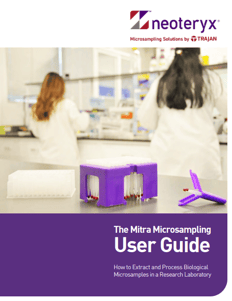microsampling in clinical trials
Decentralize clinical trials with microsampling devices designed for remote specimen collection. Remote microsampling helps to increase participant enrollment and diversity, and cut trial costs, accelerating drug development. Make the move to microsampling today!
Microsampling for Remote Monitoring
Are you conducting pediatric or adult clinical trials that require frequent blood sample collection? Our Mitra® and hemaPEN® remote blood microsampling devices offer easy convenience and volumetric precision!
Dried blood microsampling can deliver significant cost savings by eliminating the need for cold storage and cold shipping. With a volumetric microsampling device in hand, your staff or study participants can collect samples at the trial site or at home and send them to the lab using standard mail.
Welcome to precision sampling by anyone, anywhere, anytime!
Frequently Asked Questions (FAQs)
Yes, volumetric microsampling devices have been used in many clinical trials around the world. Our Technical Resource Library includes a searchable selection of published literature discussing studies and trials that applied remote specimen collection and volumetric microsampling. Type "trial" or your analyte of interest in the library's search field to find journal articles, presentations and application notes.
Many analytes can be extracted using volumetric microsampling, and are compatible with hemaPEN® and Mitra® devices with VAMS® technology. Our Technical Resource Library provides information around the types of analytes that have been evaluated by researchers using volumetric microsampling. Type your analyte of interest in our Technical Resource Library search field to find the information you seek.
Sample success rates are high for Mitra® and hemaPEN® devices, which are based on volumetric microsampling. The absorptive VAMS® tips on Mitra can absorb homogenous samples with 99% acceptance rates.* By following the illustrated instructions and demo videos available with hemaPEN and Mitra, end-users can reliably collect fixed volume samples that are precise enough for lab analysis.
These volumetric microsampling devices overcome the hematocrit (HCT) bias that may occur with DBS cards, where non-homogenous blood spots on filter paper have higher variability and higher failure rates.*
*Data on sample success rates are discussed in published research articles in our online Microsampling Resource Library.
Example: https://www.medrxiv.org/content/10.1101/2021.01.27.21250570v1.full
Published research papers show that dried capillary whole blood microsamples collected in 10, 20, or 30 µL volumes are enough for good extraction and analysis. These samples also yield high-quality data that are similar to data from venous blood. The literature provides case examples of microsampling in research applications. Visit the Technical Resource Library to review many comparative studies that describe what others have achieved with microsampling in their research.
The first step in transitioning from other sampling methods to microsampling is an introductory, initial education phase, which may take about 4 weeks. The next steps involve evaluation and validation. The Neoteryx Microsampling Team and Technical Director can provide support through all the steps:
Education: The introductory phase
Evaluation: Extraction, linearity & signal-to-noise studies
Validation: Validating your method
See our Microsampling User Guide for details.
While we are exploring this capability as a future advance in the microsampling industry, traditional wet blood samples and conventional phlebotomy are still used for most standard health panels and the complete blood count (CBC).
Dried blood sampling (e.g., using Mitra, hemaPEN or DBS cards) eliminates the requirement & expense of a certified phlebotomist to perform the blood sample collection. In addition, the shipping of dried blood samples to a central laboratory doesn’t require costly cold-chain shipping supplies/methods, but instead can be shipped via standard post.
 Microsampling User Guide
Microsampling User Guide
This technical user guide is designed to get you started with microsampling. The printed guidance from our technical director helps you make initial decisions on best practices for achieving solid analytical validations in your research projects. What microsample volume is needed for your assay? What analyte classes are compatible with microsampling? How do you process microsamples in the lab? Download the guide to find answers to these questions, and more!
Clinical Trials Blog List
We work with many organizations that conduct clinical trials, so we cover this topic a lot in our content. Click the button below to explore our blogs on how to improve clinical trials with remote microsampling – all gathered together in a single, curated list.
Microsampling for Virtual Clinical Trials: Interview
In this episode of the Microsamplify Podcast, Anders Millerhovf, co-founder and CEO of Clinical Trial Consultants (CTC) in Sweden, explains how remote microsampling devices and digital communications enable large, decentralized trials with great success.
Lower Clinical Trial Costs with Microsampling
Design a hybrid or decentralized clinical trial (DCT) with remote microsampling and telehealth communications so your study volunteers can participate from home…or anywhere. Remote sampling decreases site & staffing costs while increasing the size & diversity of your study population across wider areas.
Gain Access to the Microsampling Resource Library!
How do others use microsampling in decentralized studies and clinical trials? For answers, fill out the form to gain access to our Microsampling Resource Library, where you can find materials by selecting either the resource type, key topic, assay or by typing your topic of interest in the general search field.


